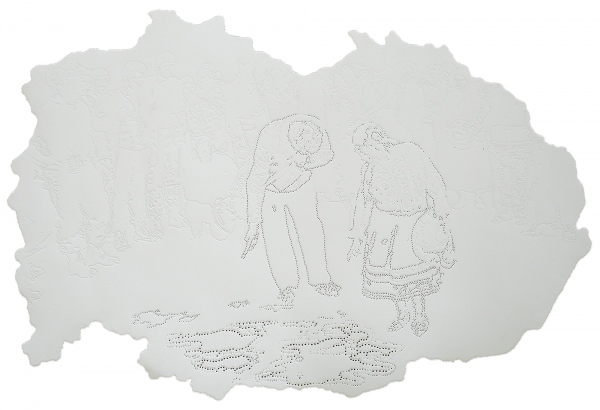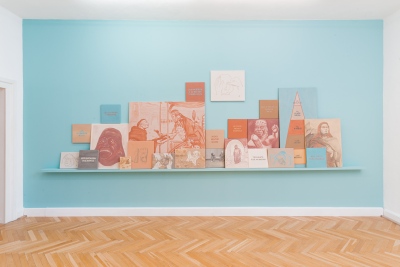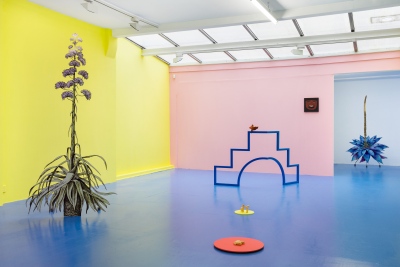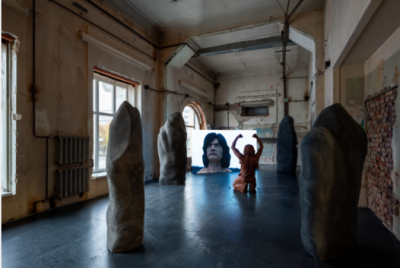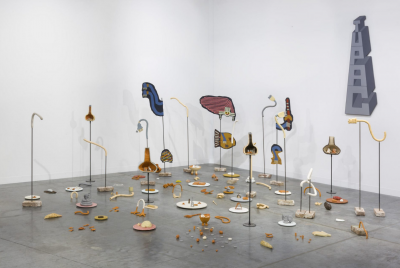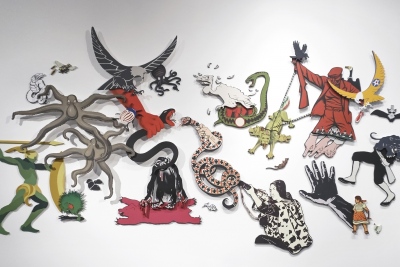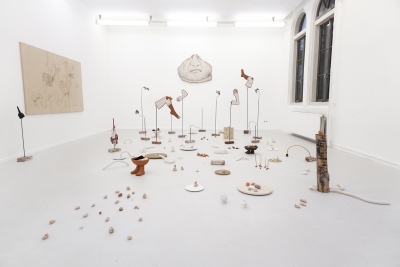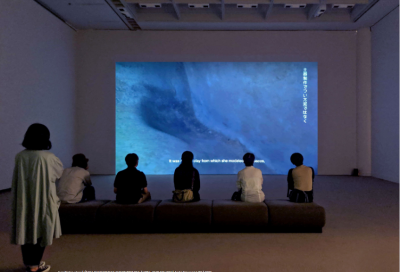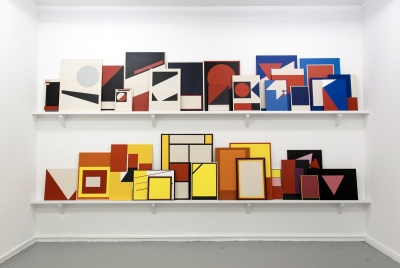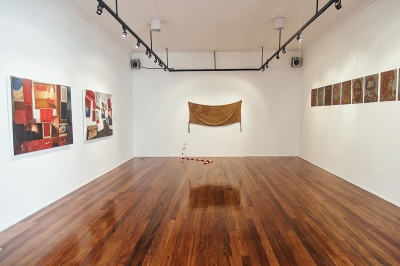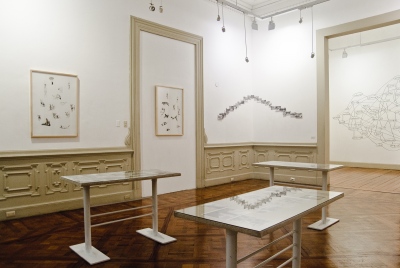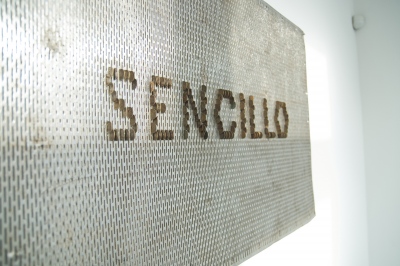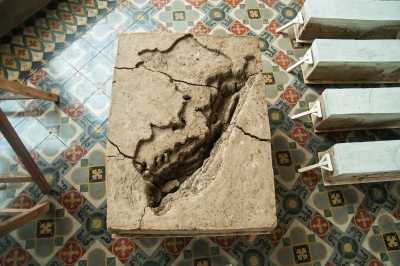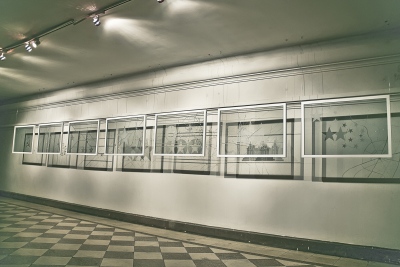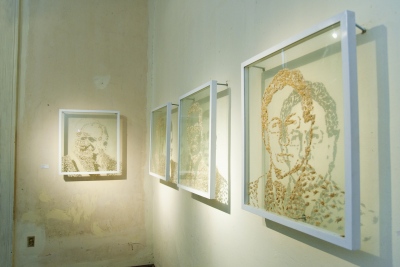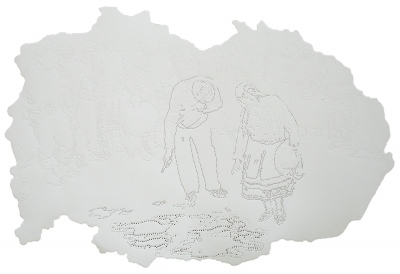Muy blanco para indio y muy poco para blanco / Too white for a cholo, not enough for a white man
2020
Clay painting installation (clay on cotton canvas)
Approx. 155 x 500 cm | 61 1/8 x 196 7/8 in
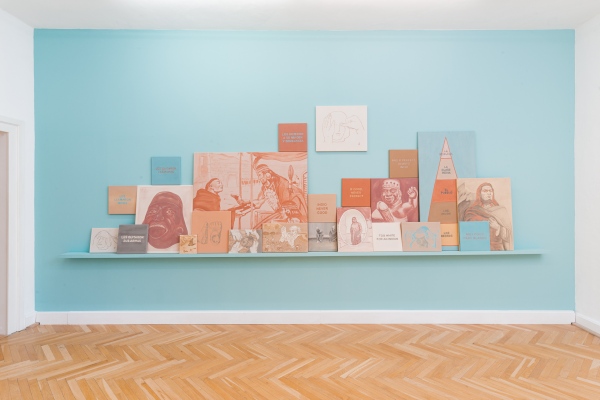
Installation view | THE FACULTY OF SENSING – Thinking With, Through,and | Braunschsweig (DE)
A las revoluciones, como a los árboles, se les reconoce por sus frutos / Revolutions, like trees, are recognized by their fruits
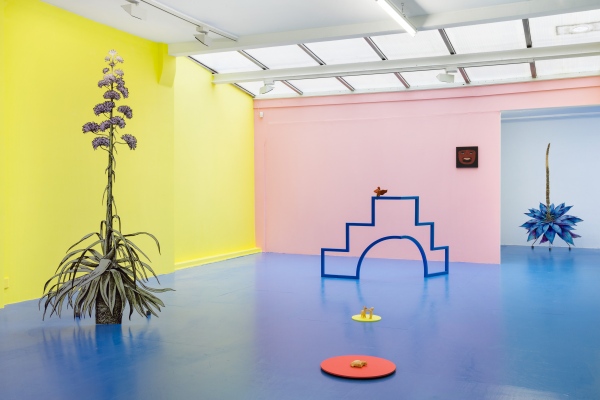
A las revoluciones, como a los árboles, se les reconoce por sus frutos / Revolutions, like trees, are recognized by their fruits, GRIMM Frans Halsstraat 26, installation view ©SM
El Creador / The Creator
2019
Soil, clay objects, sublimation prints on aluminum
Various dimensions
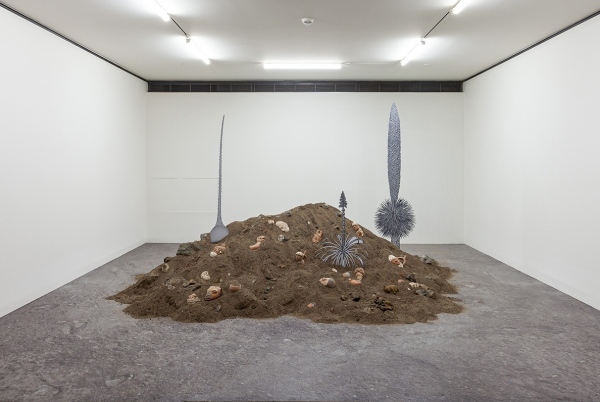
Installation view | El Creador | The Creator | 16th Istanbul Biennial: the Seventh Continent, curated by Nicholas Bourriaud, Istanbul (TR) | 2019
Y no podrán matarlo... /And they could never kill him...
2019
Digital video, 18:49
Edition of 3 plus 2 artist's proofs
5th Ural Industrial Biennial of Contemporary Art, Ural (RU), 2019

¡Kachkaniraqkun! / ¡Somos aún! / We are, still!
2018
Fired clay, bricks, metal, iron, painting with acrylic and clay on panel
Variable dimensions
In ¡Kachkaniraqkun! / ¡Somos aún! / ¡We are still!,2018 Martínez Garay’s combines standing murals, geometric forms, and ceramic works to reflect on the idea of sacrifice, invoking a strong identification with indigenous cultures. The artist has created this installation as part of an ongoing process of inquiry into the life of cultural artifacts, how they are created, preserved and circulated.
21st Contemporary Art Biennial Sesc_Videobrasil, São Paulo (BR) 2019
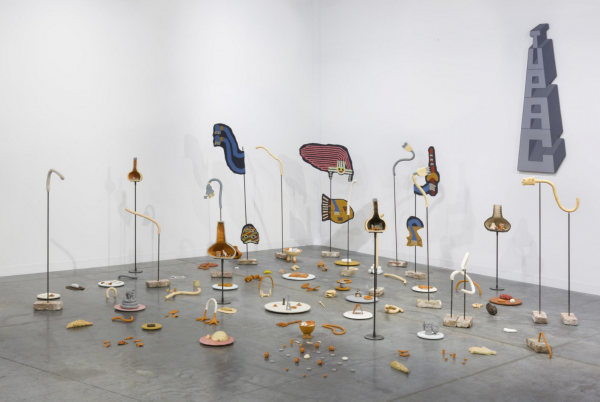
installation view | ... imaywanpas quidakuwakmi ... / ... but you can stay with my stuff ...| ART BASEL, Miami (US) | 2018
Cannon Fodder / Cheering Crowds
2018
Acrylic and varnish on wood
213 x 469 cm | 83 7/8 x 184 5/8 in
Fourth Edition Triennial, Songs of Sabotage, New Museum, NY (US), 2018

...Imaywanpas quidakuwakmi.../ … But you can stay with my stuff ...
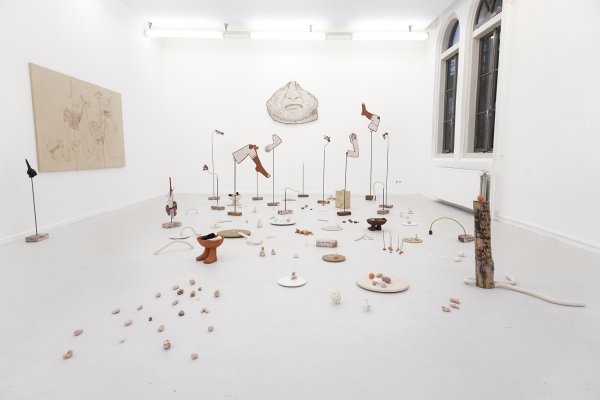
Installation view | Rijksakademie, Amsterdam (NL) | 2017
Ñuqa kausakusaq qhepayki-tapas / I will outlive you
2017
Single channel HD video and sound
15 minutes 17 seconds
Variable dimensionsEdition of 3 + 1 AP
Art in an Age of Historical Ambivalence: The 12th Shanghai Biennale, 2018, Shanghai (CN)
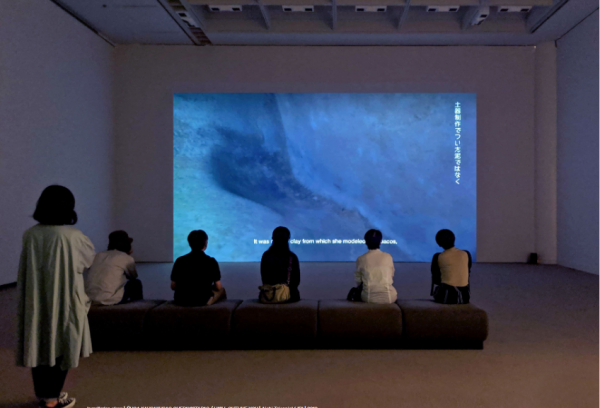
The Parade/ The Leftovers
2016
Pintura-Instalación, 470 x 370 x 25 cms.
Rijksakademie Open 2016, Amsterdam.
"The parade" has been exhibited also at Meta perspective. Dapiran art project space, Utrecht. 2017
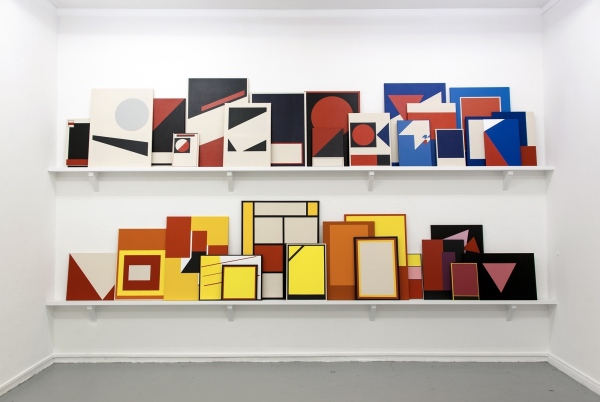
Judging a Book by It's Cover
2014 - ongoing
frottage with graphite on paper
Art item # 1
Political Sciences item #1
Political Sciences item #2
Political Sciences item #3
Political Sciences item #4
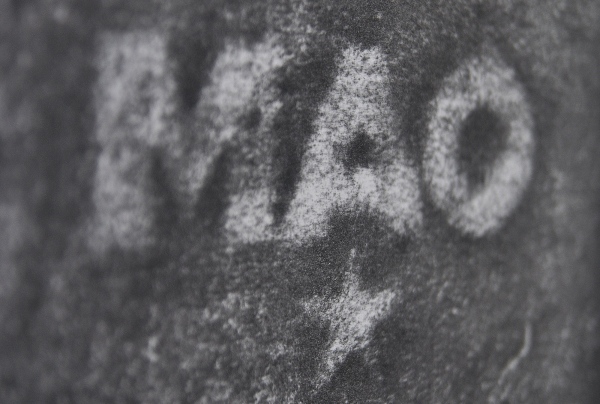
El Otro, El Mismo / The Other, The Same
2012
”I have never dared to believe anything with absolute certainty (...) when asked if I am liberal, if I am social democrat , I tell them, will have to wait to death, only then you will know” Eduardo Punset
The war that began more than thirty years ago in our country, shows us, as a unresolved and complex society, full of simultaneities. Filled with gaps.
It is through images as we remember. Although the images are representations of reality or fantasy, during the civil war, these images were able to change our perception of the facts, they were manipulated in detail to make us change, think, feel, live differently. Almost without us realizing it. They were used as evidence in court, as clues, as weapons, as demagogic resources and as tools of terror. But it was also thanks to them, that 20 years ago it was possible to capture Abimael Guzman. That is why it is crucial for me to study this information for a better understanding of our past, and not to revive it in the present.
For many of us who did not live in full awareness of the deployment and the beginning of the civil war, all that remains for us is the information in the images, the stories and versions. With time, we realize that they are all we know, versions of others, which are misinterpreted over time.
“nothing changes as much as the past” Anonymous
Our education is so designed as binary. The simple facts are often opposed, a switch is on or off, a person can be alive or not, etc.. Yet life is more complex. The fundamental units of reality are made of information and does not work in a way as simple as binary, but also in a way that to be or not to be, can be and not be, both.1
We can then release from the images displayed, simultaneous opposing concepts: win / loss ; reveal / hide ; original / copy ; reality / representation ; presence / absence ; good / evil ; right / left ; life / death, etc.
What this exhibition seeks is not to reaffirm the obvious, but rather reveal the simultaneities coexisting in the images with which we interpret the past. It is an invitation to admit, recognize and embrace uncertainty and contradictions which we live in.
1. According to quantum physics, a particle does not have a specific position or power, until the moment when an observer attempts to measure it, and it is only then, when the observer receives the information that a particle is in a determined state.
El Otro, El Mismo. Galerie L'imaginaire, Alianza Francesa de Lima. 2012
"el trofeo es el mismo" has been exhibited also at the Centro Cultural Inca Garcilaso of the Foreign Affairs Ministry of Perú.
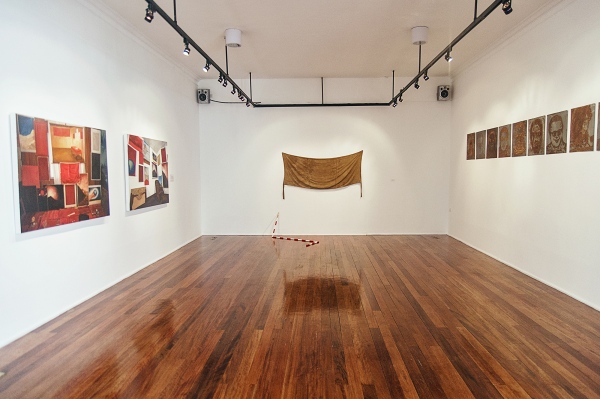
Todos los perros van al cielo / All dogs go to Heaven
2013
In the “Confidences and Omissions” series we can see a selection of 11 books that discusses the subject of the peruvian conflict from different enunciation points. From the book by a renowned journalist to a retired military officer. Everyone trying to show their version of something as complex and still unclear of what happened in the andes.
These books have been reproduced in plaster, covering the fragil adobe structure behind it.
This artwork seeks to show the place that dogs have taken in war, like the hanging dog, bomb dog, messenger dog, police dog, guard dog, etc. Everyone had to play a role in the place where they were born. Reality defines us. These drawings are based on photographic archives of war, occurred in Peru and other countries.
Centro Cultural Inca Garcilaso of the Foreign Affairs Ministry of Perú.
"Doggie's Heaven" and "In-herences" were part of the 12 Cuenca Bienal in Ecuador, 2014.

El Imperio del Sol / Empire of the Sun
2011
The value that we attribute to metal, is a fiction, is not what it’s worth, but what we need it to be. The iconography of the coins is the starting point to question the value of our culture, how this came to us transforming itself and how the systems of negotiation in which we live in works. We are carrying on our backs our cultural inheritance, in a piece of metal of different denominations.The importance of the Sol* and the nature in the Andean life, has come to us from hand to hand. The man had the Inti as his creator, and because of it, was adored and people came to him in search of favors and help. The life at that time, was governed by a constant negotiation by the Inti (god sol/sun) and other gods.The Sol blurs the limit between the reality and the fiction across time, as a new cosmovision. At some point, we stop staring the sky, to look at what is on our hands.*Meaning both the sun and the peruvian currency.
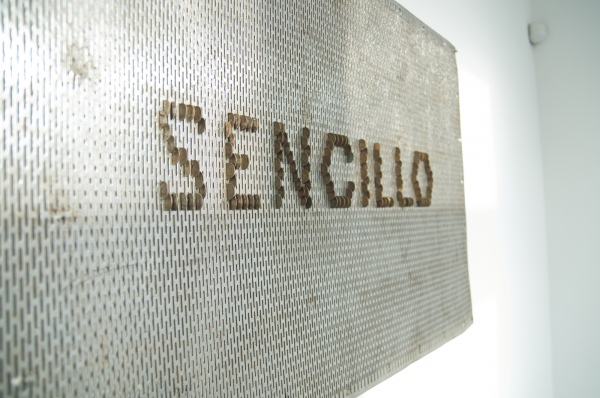
sencillo
coins and stainless steel 110cm x 80cm
Perú Profundo: Elevó, Oprimió, Arrastró / Deep Peru: Raised, Opressed, Dragged*
2011
Sculpture instalation (cement, adobe, wood) three pieces of 70 x 100 cm
*Raised, Opressed, Dragged, are some of the most significant words from the peruvian national anthem.
The map of Peru and its boundaries are the limits of our geopolitic portion, and its representation, engraved in our memory, is the contoured and flat shape, which contradicts the reality itself, there are elevations, accidents and depressions, volume and gaps.
The map in concrete is the official, the known and valid, where the mountain is the highest. However, when talking about the mountain, it is colloquially called Deep Peru. It is understood the inverse.
The official does not equal the real. To build is not the same as establish. Progress does not equal development.
Our recent history reveals us as a country fractured in two, the official Peru and the real Peru (deep Peru). Where one takes over and builds on the other. One defines and marks the other. Both worlds give themselves the back.
When trying to copy, or leave the footprint of the concrete matrix in the adobe (mud and straw), the result is not equal to the original, but the opposite. It is the deep Perú.
I used to think that, in order to the reconciliation to come, the war had to end, now I know that the first must begin in order that this one finishes. Frontal facing and the mixture could be the beginning.
1st Prize in the XIV National Art Contest Passport for an Artist, organized by the Alianza Francesa de Lima. Centro Cultural PUCP, Lima.

Algo Que Vino y Se Fue / Something That Came and Went
2011
Instalation
7 engraved and broken glasses, rusted sickle and light.
4ta. Trienal Poli/Gráfica de San Juan: América Latina y El Caribe. San Juan, Puerto Rico, 2015.
Imágenes desplazadas/Imágenes en el espacio
Curada por Gerardo Mosquera, Alexia Tala y Vanessa Hernández.
Licencias para narrar, 80mts2 Gallery, 2011.

El Perú Avanza / Peru Advances
2011
Crabs on glass, Light
4 pieces of 72 x 65 cm
Portraits of the latest former presidents of Peru: Belaunde, García, Fujimori and Toledo (3 of them have been reelected). These portraits have been built with small crabs found on the beach. It is said the crab walks backwards or sideways, but what is said of the Peruvian crab is that he is also selfish. The shadow on the wall crabs draws the portraits of former presidents at the time of their designation. The title of the work, “Peru Avanza” (Peru Advances) was taken from the slogan used by the previous government in its first term, which led the country into a deep economic and social crisis. In that sense, it is inevitable that the real meaning of the slogan is put into question.
¿Y qué diría el Mar? Asia Golf Club, SURA, Lima, Perú, 2014. Curated by Florencia Portocarrero.
Miradas sin coordenadas. 80mts2 Gallery, Lima. 2011.

Detrás del ícono / Behind the icon
2010
Digital printing and silkscreen with varnish.
5 pieces of 90 x 60 cm.
Popular images during the civil war are presented without its constitutive element, ceasing to be iconic and remaining as common landscapes and being looked away from all media at this moment.
They are remote places, unprotected and outside the eyes of most people, everyday story just for their habitants, but still, with a loud and intense story, and in some cases the stories are part of the present, urgent and yet invisible.
The contradiction between the remote and peaceful landscape with the new reflecting image (when the viewer approaches to the work) will be evident, as it is when you get to see the missing element of the iconic photo, which will make the viewer complete the mental image and re- member the time, place and particular history, thus demonstrating that even what we don’t remember, is never forgotten, everything remains.
Anamnesia- Claudia Martínez Garay / Rudolph Castro / Santiago Quintanilla. Micromuseo alfondohaysitio. Petro Perú Gallery, 2012. Curated by Gustavo Buntinx.
P/A Pruebas de Artista. III International Bienal of printmaking ICPNA, Gallery Germán Kruger Espantoso, ICPNA, Lima, 2010.
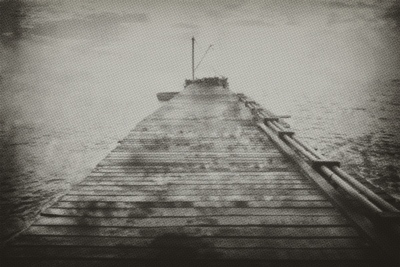
Después de 186 años, aún se sigue luchando / After 186 years, still struggling
2010
DipticPlexiglass
Drawing on aluminium
2nd Prize in the II National Painting Contest. Central Reserve Bank of Peru.
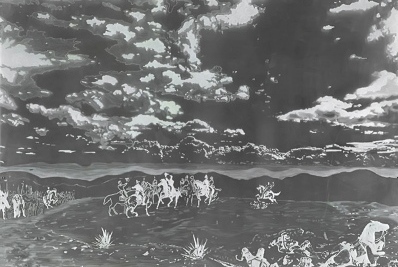
Invisible
2007, 2009
Holes (incision) on paper
The eighties showed the deep contrast in which even now, the Peruvians live with. Lima, where the economic and political powers are centralized, lived behind a civil war wich occured inside the country. Even though we see the violence of those years, we never wanted to deal with the dimension that had been reached. There are political sectors that insist on keep on forgetting the disasters of war and their reasons are divers. Postponing the construction of the memory of the years of violence is part of its strategy. Disguise was state policy, and we all submit and accommodate to that.
Invisible, argues about the blindness we keep to hold alien other reality; not about the imposed blindness, but for which we are accomplices. Martinez shows us the emptiness and existing silence, showing what we do not want to see, remember and know.
Ayacucho, its provinces, its people, their stories; are the backdrop that Claudia chose to show the wounds of a hidden war. In each province she etched with a needle pictures and testimonies of horror and pain. She strikes the paper, builds the story with deep holes and repeats it again and again, her action reminds us of more than 69,000 Peruvians we lost. The white color paper is the support, does not transgresses, respects and chisel a subtle mark, for in it we discover what is yet latent.
Martinez invites us to discover our past, blocking the view of the image by making it hard to see, for in it ́s unveiling we can build a memory and on it, we reflect on the history.
After four years of the Final Report of the Commission for the Truth and Reconciliation, we have not yet been able to see clearly the awful footsteps of our recent past. Therefor Invisible, is both timely and essential.
Claudia Coca - artist
Anamnesia- Claudia Martínez Garay / Rudolph Castro / Santiago Quintanilla.
Micromuseo alfondohaysitio. Petro Perú Gallery, 2012. Curated by Gustavo Buntinx.
Invisible. Gallery 80mts2 arte&debates
